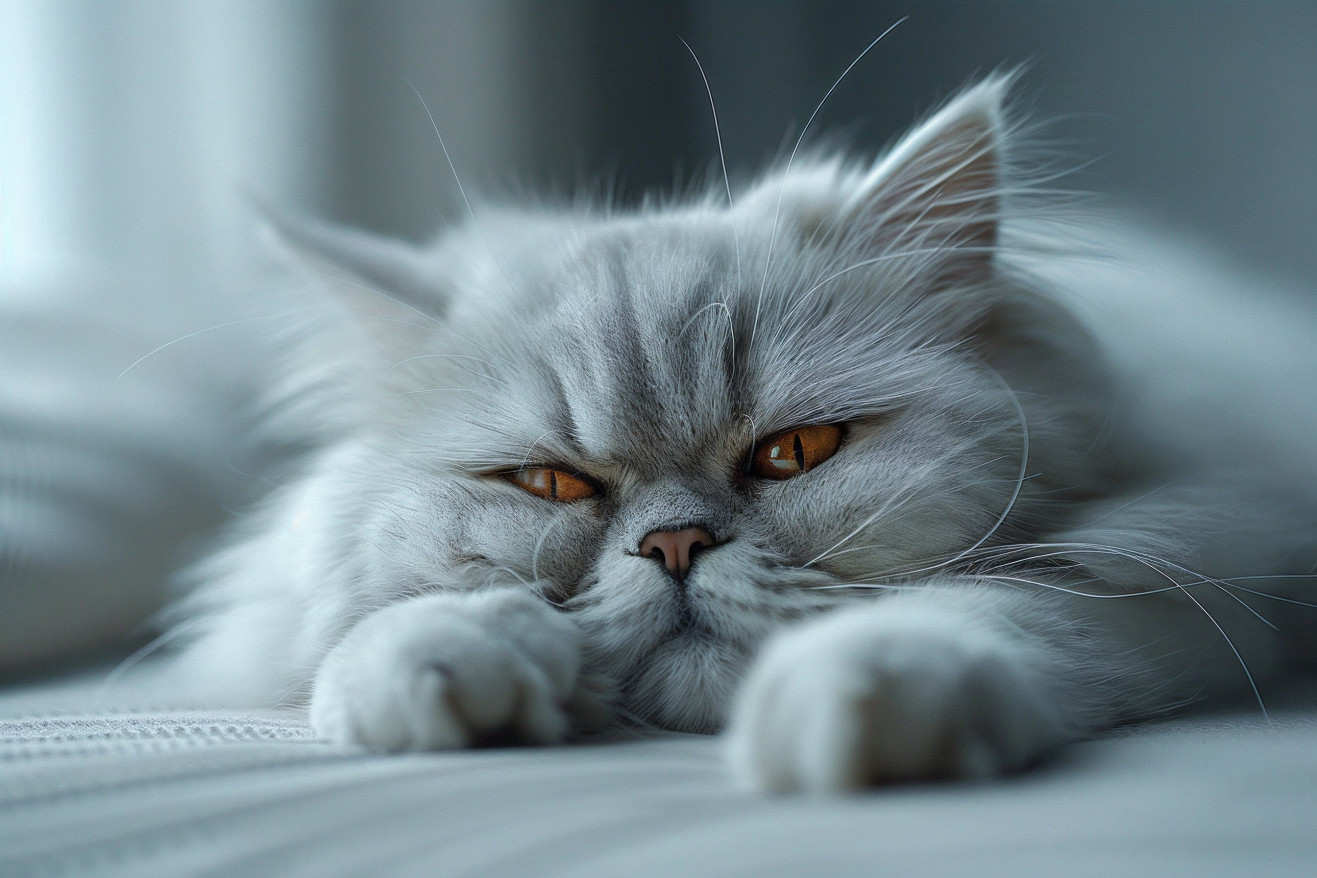Can Cats Have Headaches? Signs of Pain in Cats
21 February 2024 • Updated 22 February 2024

Just like their human companions, our feline friends might also experience the throb of headaches. While cats can have headaches, it can be difficult to tell. A cat that is experiencing a headache may exhibit a change in behavior, including hiding or becoming more aggressive. If you think your cat has a headache, it’s important to take them to the vet for a proper diagnosis and treatment.
In this article, we’ll help you understand why it can be so hard to tell if your cat has a headache by looking at information from veterinary medicine, animal behavior, and neuroscience.
We’ll also go over how to recognize signs of pain in cats and the clinical tools used to diagnose pain, as well as the anatomy and physiology of pain in cats. By the end of this article, you’ll have a better understanding of how cats experience and show signs of headaches, so you can better help your cat when they’re in pain.
Can cats have headaches?
Inside the World of Cat Senses: How Cats Perceive Pain
The sensory system of cats is highly evolved, and the perception of pain is the result of a complex interaction between the nervous system and other physiological systems. According to the Merck Veterinary Manual, the process of pain perception in animals, including cats, can be broken down into five stages: transduction, transmission, modulation, projection, and perception.
These stages involve the conversion of stimuli into nerve impulses that are then transmitted to the central nervous system, where they are modulated by the peripheral nervous system. The impulses are then projected to the brain, where they are perceived as pain.
Cats can feel three different kinds of pain: acute pain, which is sudden and often short-term; chronic pain, which lasts for an extended period of time; and neuropathic pain, which is caused by damage to the nerves. Each type of pain requires a different approach to treatment and has different effects on the animal’s quality of life.
Veterinarians use validated methods to evaluate pain in cats based on the animals’ expressions and behaviors. One of these methods is the Feline Grimace Scale, which is detailed in the 2022 ISFM Consensus Guidelines on the Management of Acute Pain in Cats and offers a useful and objective way to assess pain based on facial expressions.
Understanding these methods is important for identifying diseases that may cause pain and making sure that our pet cats are as comfortable as possible.
Understanding Pain: How Cats Show Pain Behaviorally and Neurologically
Cats that are in pain or discomfort may show certain behaviors that can help their human caregivers understand what they are going through. These behaviors can include a loss of appetite, increased vocalization, changes in grooming, and a lack of interest in jumping and playing. They may also become more withdrawn or, on the other hand, more demanding of attention.
In addition, neuropathic pain can be indicated by limping, skin twitching, or licking or chewing at certain areas of the body, according to PetMD.
Veterinarians will use a number of neurological assessments to determine if a cat is in pain, including thorough neurological exams, which are outlined by the Merck Veterinary Manual. These exams include reflex, muscle, posture, coordination, and gait tests. They will also use advanced diagnostic imaging, such as MRIs and CT scans, and cerebrospinal fluid analysis to determine the source of pain, which can include inflammation and nervous system tumors.
While it can be difficult to determine if a cat is experiencing a headache, the combination of pain behaviors and neurological assessments can help. If a cat is showing signs of pain and there are abnormalities found in neurological exams, this could indicate a more serious issue that could be impacting the brain, such as a headache.
This information is important in making sure that cats receive the care they need and that they are as comfortable as possible.
Solving the Puzzle: How Veterinarians Diagnose Headaches in Cats
In the world of veterinary medicine, diagnosing headaches in cats is especially difficult. While pain assessment tools like the Glasgow Composite Measure Pain Scale have been adapted for use in feline patients to assess acute pain through behavior in clinical settings, these tools do not account for the complex nature of headaches in cats.
Headaches in cats can be difficult to detect due to the cat’s natural tendency to hide pain and the subtlety of the symptoms.
Veterinarians typically use a combination of clinical signs, owner observations, and advanced imaging to diagnose neurological issues. The American Veterinary Medical Association notes that the Feline Grimace Scale is a useful tool for veterinarians to assess pain based on facial expressions, which helps to fill in the gaps in the detection of clinical signs of acute pain that may be associated with a headache.
Owners are also important in this process, as they are often the first to notice changes in their cat’s behavior that could be indicative of pain, including changes in activity levels and even how they respond to being pet.
While there are few case studies that focus specifically on feline headaches, veterinarians use these diagnostic tools to help them determine whether or not a cat is experiencing headaches and to develop a plan for managing them.
Easing the Pain: How Cat Headaches Are Treated
Just as with humans, a personalized treatment plan is essential to help ease the pain of your cat’s headaches. As mentioned by PetCareRx, one of the most important parts of managing your cat’s headaches is managing environmental stress.
This can be done by creating a calm environment for your cat, making sure there aren’t loud noises around, and making sure your cat has access to soothing activities and toys. Regular trips to the vet can also help catch some of the conditions that can lead to headaches before they get too severe, according to the Cornell Feline Health Center.
Diet is also an important factor in managing your cat’s headaches. Making sure your cat has a healthy, well-balanced diet and gets enough exercise can help prevent some of the health issues that can lead to headaches. In addition, your vet may recommend dietary changes, such as a low-sodium diet, especially if your cat has conditions like high blood pressure, which is a common cause of headaches.
When it comes to medication, your vet may prescribe pain relievers that are safe for cats, although it’s important to note that some pain relievers that are safe for humans, including some NSAIDs, can be toxic to cats. In more serious cases, hormonal imbalances and neurological conditions like brain tumors may require more aggressive treatments, including medication or surgery, according to the MSD Veterinary Manual.
If your cat is showing symptoms of headaches that are severe or that don’t go away, it’s important to take them to the vet to find out what’s causing the issue and to get the appropriate treatment. With the help of a vet, you can come up with a treatment plan that will help your cat find relief and have a better quality of life.
In Conclusion: The Mystery of Cat Headaches
As we’ve delved into the world of feline pain, we’ve learned that cats can, in fact, get headaches just like people. In fact, IVC Journal notes that it’s believed that any animal with a head and the ability to feel pain can get headaches. This, of course, includes our mysterious feline companions, who are often left to suffer in silence due to their stoic nature and our inability to communicate with them.
Because cats can’t tell us when they have a headache, it can be difficult to diagnose. This is where veterinarians come in. They can use their knowledge and powers of observation to help cats who are suffering from headaches. In fact, IVC Journal’s study shows that it’s important to monitor cats for signs of headaches, like a clenched jaw, nervousness, and head pressing.
So while the mystery of the feline headache may never be solved, it’s important that we continue to monitor and care for our feline friends. Whether that’s through the use of holistic treatments like Tellington TTouch or the care of a veterinarian, it’s up to all of us to make sure that a life free of headaches isn’t just a human right, but a feline one as well.


